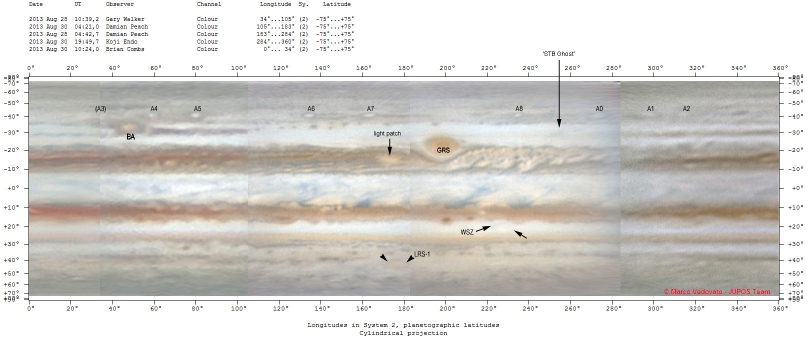[1]
Jupiter
in 2013/14: The new apparition begins (Sep 3rd.)
Hello, Jupiter enthusiasts.
The new apparition of Jupiter is under way, so here are some notes on it.
 Download full bulletin in PDF.
Download full bulletin in PDF.
~~~~~~~~~~~~~~~
1. Filenames:
- - - - - - - - - -
The start of the apparition is the ideal time for all observers who do not yet
use the required format to start doing so. All images *must*
have filenames which include the date in the order year-month-day, followed by
an abbreviation of the observer's name or initials. The
format used by the professional PVOL database is becoming most generally
accepted:
jYYYY-MM-DD_HH-MM_filter_obs.jpg
for example:
j2013-11-01_01-56_rgb_ABC (which includes the time, 01:56 UTC, and observer
ABC). Alternatively, use our own preferred format:
2013nov01_ABC (and you can include several images in a single JPEG
file). Please do use one of these formats, with exactly the correct punctuation.
2. For people in the UK next week:
- - - - - - - - - - - - - - - - - - - - - - - - - -
The European Planetary Science Congress is in London next week and there is an
associated BAA meeting all day on Friday Sep.13. This will be a
workshop on "Amateur Contributions to Solar System Studies".
Several of our European colleagues will be there giving demonstrations of the
use of the JUPOS and fireball-detection software. So it will be a unique
opportunity, and anyone is welcome. Details on the BAA web site:
http://britastro.org/
3. Jupiter at the start of the new apparition:
- - - - - - - - - - - - - - - - - - - - - - - - - - - - - -
Attached is a map made by Marco Vedovato from recent images, and here are some
notes on some features of interest, including first results
from JUPOS analysis by Gianluigi Adamoli and Michel Jacquesson.

The planet looks generally normal (quite a change from a year ago!). The NNTB
has largely reappeared. NN-LRS-1 is still a large reddish oval,
at L2 = 177. The NTB, following last year’s revival, is in a typical state
with a N component consisting of narrow grey streaks, and a S component which is
bland and pale orange. The NEB has returned to a normal width, with some dark
barges along its irregular N edge, and some typical large dark formations on its
S edge. The SEB is normal, and the usual ‘rifting’ f. the GRS is extensive
and active. The GRS is still strongly orange and isolated, indicating a lack of
incoming SEBs disturbances. The STB comprises a single long dark segment, f.
oval BA, to be discussed below. The nine long-lived SSTB white ovals are all
still present.
Major spots of interest:
In the NTropZ, the very long-lived white spot Z (WSZ) is sstill present, at L2 =
226, although it has quite low contrast against the bright
NTropZ. It is still rapidly prograding, with DL2 = -23 deg/month. (This is
not as fast as its motion last autumn, when it peaked at -42
deg/month.) It will soon be interacting with two dark barges on NEBn.
In Chris Go’s image on Aug.31, WSZ is remarkably methane-bright.
In the SEB, the strange long-lived light patch has now almost reached the p. end
of the Red Spot Hollow. In the latest images (Chris Go and
Rich Jakiel, Aug.31), it has resolved into a simple oval form, probably an
underlying cyclonic oval as has been suggested by a few v-hi-res
images in the past. Its interaction with the Red Spot Hollow over the
coming days or weeks will be very interesting to observe.
In the STB, oval BA is still a well-defined orange oval (see image set and JUPOS
chart on next page), and we can now see the aftermath of the
collision with STB dark segment D in the last apparition. As we predicted*, oval
BA has accelerated dramatically! Initially, last apparition, it did not do
so** – indeed it may even have slowed down (from DL2 = -12 deg/month to ~-9
deg/month). This was probably because,
when the incoming STB dark segment arrived f. oval BA, it did not form a long
turbulent dark segment as in previous such events, but instead
broke up into a chain of cyclonic ovals. Since solar conjunction, this
chain has been replaced by a long dark segment after all, and
accordingly, oval BA has accelerated at last (to DL2 ~ -16 deg/month). Moreover,
the other expected consequences of the collision are also
evident: a very dark collar around oval BA, and dark spots emitted on the STBn
jetstream p. it, and in the STZ f. it. The attached image set
shows how the STBn p. oval BA, which was tenuous last year, is now much darker
with tiny prograding spots (red arrow).
One other feature in the STB deserves attention: a very faint blue-grey streak
at L2 ~ 253. This evolved from a very dark spot in 2012, and we
have suggested that it is the next STB structured sector, so it will be called
STB segment E or, more familiarly, the ‘STB Ghost’, since it
closely resembles the earlier ‘STB Remnant’. (It is best shown in
Damian Peach’s image on Sep.2.)
*[Refs to our previous reports - see PDF version]
John Rogers
2013 Sep.3
_______________________________
John H. Rogers, Ph.D.
Jupiter Section Director,
British Astronomical Association
John H. Rogers, Ph.D. Jupiter Section Director,
British Astronomical Association
jhr11@cam.ac.uk
http://www.britastro.org/jupiter/
 Download full bulletin in PDF.
Download full bulletin in PDF.
